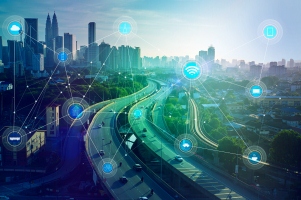The rate of global urbanisation is growing exponentially. But while living in cities offers both social and economic opportunities, the rising costs of living are threatening to increase social inequality, slow down economic growth, and increase levels of crime.
Smart cities, and the technologies that underpin them, are hailed as a significant solution to this problem, and are set to reduce costs for governments, citizens and enterprises alike. In fact, a recent report published by ABI Research, in partnership with Chordant and CA Technologies, reveals smart city and IoT technologies have the potential to save governments, enterprises and citizens globally over $5 trillion (€4.09 trillion) by 2022, says Jim Nolan, executive vice president, Chordant at InterDigital.
Specifically, it is new sharing and service economy paradigms, and the “Internet of Things” along with artificial intelligence (AI) and automation, that will play a leading role in driving these cost savings.
Cutting costs for governments
Governments can benefit tremendously from the implementation of IoT technology and sharing economy business models in energy, water utilities, transportation, and crime and vandalism.
Energy savings is perhaps the first, and most obvious cost benefit of IoT and smart city technology. Turning street lights into smart, connected systems with intelligent on/off cycles, for example, could yield a 30% cost saving for governments.
When it comes to water utilities, advanced leak detection systems can drive direct cost savings by removing the need for manual inspection, while opportunity cost savings can be made through water waste management and waste prevention systems. These cost savings, in turn, help to reduce end-user prices.
Transportation is a major cost centre in government budgets, but adding smart technology such as electronic toll collection (ETC) vehicle to infrastructure (V2I) technology, as well as intelligent traffic light systems, can optimise the use of existing road capacity.
In regard to government services such as waste collection, mobile resource management (MRM) technology can dispatch, manage and monitor field workers, while the deployment of smart garbage bins can enable real-time, remote fill-level monitoring, and therefore the timely dispatch of garbage collection trucks. This isn’t a fantasy, they’re already in use in Dubai. This enables waste collection fleets to run more efficiently and results in fewer trucks on the road. In fact, this form of smart waste collection has the potential to reach cost savings of 30%.
Finally, AI-based automation for surveillance cameras, along with data optimisation, can reduce the costs associated with monitoring and analysing video footage in support of crime reduction. AI technology can also be used to complement surveillance cameras with crowd sourced intelligence such as data captured from social sites, as well as smartphone footage from citizens.
By taking advantage of these different technologies, city governments in mega cities (a metropolitan area with a total population in excess of ten million people) globally could save up $58 billion (€47.40 billion) annually.
Affordable services for citizens
Smart city technologies are not only key for driving cost savings for governments – they play just as important a role in reducing costs for citizens. After housing, mobility presents the second largest item in family budgets. The shift of urban mobility to ride sharing, mobility as a service (MaaS) and in the longer term, driverless car-sharing, will therefore all lead to significant cost savings for citizens.
Cost savings can also be made in utilities such as energy, water and communications through the deployment of home-based microgrids, as well as by adopting smart home solutions and energy and water saving appliances, along with consumption monitoring and metering equipment.
Rising healthcare costs are a real concern for citizens, and technology that can transform existing practices into new models, such as remote healthcare, can reduce hospital stays, not only driving cost savings for consumers, but for the healthcare sector as well.
Finally, smart education, with remote, online curriculums offer a viable alternative to the rising costs of education. Adopting hybrid approaches, where schools and universities add online capabilities, can improve flexibility and can also reduce the total cost of education.
Again, adopting these different technologies has the potential to save citizens in mega cities globally over $3 trillion (€2.45 trillion) annually.
Savings for enterprises
While the cost-saving opportunities for governments and citizens can be applied to governments, citizens, and some enterprises, additional, enterprise-specific opportunities also exist.
Freight transportation, for example, can benefit from IoT technology, allowing shippers to select the most flexible and affordable transport based on cargo capacity.
Optimising and maximising the use of limited building and manufacturing plant assets is another area where technology and sharing paradigms will bring cost advantages, specifically through building energy management and microgrids for energy efficiency; office space sharing marketplaces and flexible home and remote working policies that minimise occupancy; and smart manufacturing technologies that reduce downtime.
Enterprises in mega cities around the world could save $1.66 trillion (€1.36 trillion) annually by adopting these types of technologies.
The shift to sharing
For smart cities, embracing the sharing economy should be a key part of any smart city vision. But tying these different technologies, platforms and solutions together into one holistic, automated, closed-loop system that will work autonomously, and will alter parameters based on data to regulate supply and demand, presents a huge challenge.
However, bringing together ecosystem players and technology suppliers together into dedicated marketplaces can make this smart city vision a reality. By aggregating multiple ecosystem partners and providing scalable, interoperable, and vendor-agnostic platforms, data services, and applications, these marketplaces can seamlessly be integrated into legacy platforms and migrated onto new platforms at minimal cost.

One great example in the UK is the oneTRANSPORT initiative, which is based on an open, standardised marketplace for transport data (the oneTRANSPORT™ data marketplace), and is a perfect example of how governments and the private sector can enable new business models through a shared marketplace.
By enabling transport information to be published by data producers (like transport authorities and new third parties), and accessed nationally by transport authorities, application developers and others, cities can deliver a better travel experience, as well as generate revenues. This model allows transport authorities to leverage economies of scale, as well as reduce costs in the longer term.
The open, smart city future
With cities continuing to grow, and the costs of living in cities increasing, governments, citizens and enterprises need to take advantage of the technologies available to make cities more efficient, affordable and safe. IoT technologies and sharing paradigms should be a key element of any smart city vision to help create a more sustainable environment.
Smart cities provide opportunities for all stakeholders involved. For technology suppliers, a huge opportunity exists to position solutions and justify smart city projects and deployments by demonstrating the tremendous $5 trillion (€4.09 trillion) cost savings that can be made.
The author of this blog is Jim Nolan, executive vice president, Chordant at InterDigital
Comment on this article below or via Twitter: @IoTNow_OR @jcIoTnow










